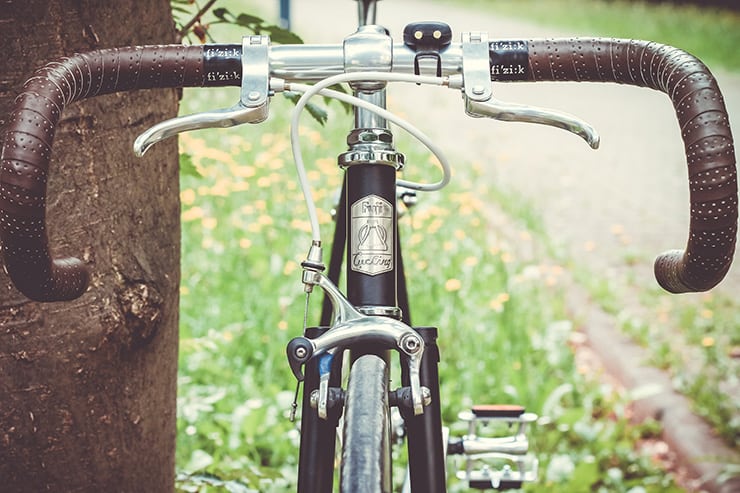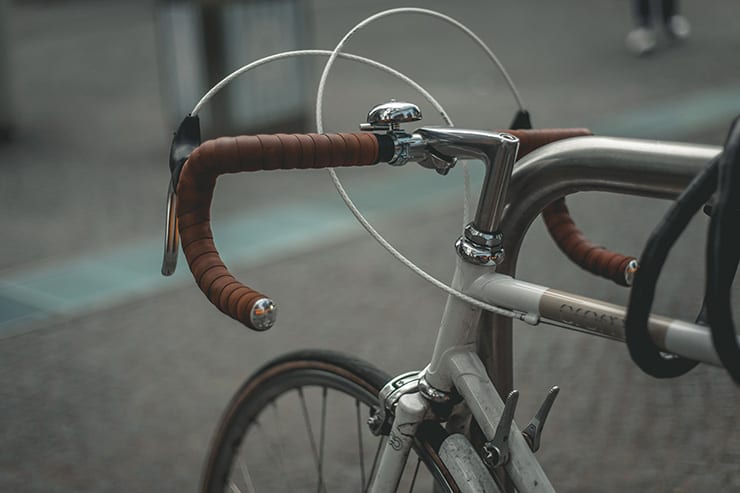Road bikes are popular for touring and commuting as they ride best on smooth surfaces like pavement. However, these models also come with odd-looking handlebars. Why are road bike handlebars curved?
This article will explain why road bikes have curved handlebars, offer some riding advice, and provide some pros and cons. By the end of this article, you’ll know everything you need to know about drop bars and if they are the best choice for your riding style.
Key Takeaways
- Road bike handlebars are curved for greater speed, efficiency, and comfort1. They allow for different hand positions and lower wind resistance.
- There are three types of drop handlebars: classic, anatomic, and compact. They differ in their width, reach, and drop.
- The three main hand positions on drop bars are the hoods, the drops, and the tops. Each position has its own advantages and disadvantages.
- It is possible to install flat handlebars on a road bike. They may offer more control and stability, but less aerodynamics and efficiency.
Key Takeaways
- Road bike handlebars are curved for greater speed, efficiency, and comfort.
- There are three types of drop handlebars including classic, anatomic, and compact.
- To install traditional handlebars on a road bike, you’ll need to measure the bike stem and install new brakes and shifters.
Drop Handlebars Explained
Unlike regular handlebars, drop handlebars are lower and have a distinct rectangular shape. You will often find them on road bikes as these models are built for speed.
In this section, I will detail three distinct features of drop handlebars: width, reach and drop. It is good to become familiar with these terms as they are often used to describe different handlebar holds and positions.
- Width. Road bike handlebars are typically narrower than others, which helps to fit between traffic and tight places. Typically, the width of the handlebars will match the rider’s shoulder width, as this increases efficiency and lowers drag.
- Reach. Reach refers to how far out the handlebar reaches; in other words, it’s measured from the tube’s center down to the handlebar’s apex. On some handlebars, the apex is sharply curved, whereas on others, it’s more relaxed. The curved apex determines how snugly your hand fits into the handlebar.
- Drop. Finally, drop refers to the vertical length of the bars, from the top of the handlebars to the lowest point. Road bike handlebars typically have a drop of around 15 cm.
Road Bike Handlebar Pros

While drop bars may look less comfortable than flat bars, they still have several benefits. Whether it is increasing efficiency or allowing for a variety of hand positions, there are a few reasons why some cyclists prefer these over a flat or riser bar.
Easy to Fit in Narrow Areas
While mountain bike handlebars are straight and wide, curved drop bars are much narrower. This means you can easily weave in and out of traffic while commuting or fit through small alleyways for shortcuts. You won’t find an area too narrow for most bikes with drop bars.
Aerodynamics
One of the main pros of drop bars is that they help to increase aerodynamics. While cyclists ride in a more upright position when riding bikes with flat bars, drop bars encourage a lower riding position.
This crouched-down position helps to decrease drag, ultimately increasing efficiency and speed. You will notice this effect most when riding in areas with high air resistance, such as riding downhill or particularly windy areas.
Multiple Hand Positions
Another benefit of curved drop bars is that there are multiple places to put your hands, making it the perfect handlebar for those who like to switch things up.
This will be particularly helpful during longer rides; sticking to one hand position for hours on end may be uncomfortable.
While I will explain more in detail below, there are three main hand positions to choose from: the hoods, the bottom of the bars, and the tops.
Better for Riding Uphill
One reason why road bikes have curved handlebars is that it makes it easier to climb hills. This is because the bars encourage a forward leaning position, which decreases resistance and allows you to put more power into your legs.
Ultimately, road bicycle handlebars allow you to have the most aerodynamic position for climbing compared to other models like mountain bikes. If you tend to bike in areas with many hills, the curved handlebars on road bikes will be your best friend.
Roadbike Handlebar Cons
Even though road bike bars have plenty of benefits, there are a few cons to consider. Depending on your preferred riding style and terrain, this list may help you determine if other handlebars, like flat or riser bars, will be better for you.
Less Control and Stability
One con of the dropped handlebar is that you tend to have less control and stability. Due to its narrow shape, you won’t be able to turn as quickly as you would with wider handlebars, as you won’t have as much leverage.
If you often bike in areas where you need to make frequent tight turns and want more control, drop bars may not be the best option.
Brakes May Not Be Easily Accessible
Since you can switch your hand position while using drop bars, the brakes may not always be easily accessible. For instance, if your hands are resting on the tops, you’ll have to move your position to brake.
This could introduce safety issues if you are riding on the road. This is much different from other models, as you typically won’t need to move your hand on a flat handlebar to engage the brakes.
May Not Feel As Comfortable
Riding a road bike may feel less comfortable if you are used to riser bars or cruiser bars. Not only will your hands be in an odd position, but your posture will also be different on the bike. Everything may feel unnatural until you get used to it.
Different Types of Drop Handlebars

While most road bike handlebars will look similar, there are three main types that you can choose from. They all have their own perks; your choice will most likely depend on personal preference.
- Classic. You will find classic handlebars on most road bikes. Classic bars have a deeper drop and longer reach than other types of bars. The classic will be a good choice if you want to maintain a forward-leaning position.
- Anatomic. While anatomic may look similar to the classic, this type of handlebar has a uniquely shaped drop. The drop on anatomic bars is shorter than classics and less curved, so some cyclists prefer this style due to comfort.
- Compact. Compact handlebars are precisely what they sound like; a compact version of the classic drop bar. The bar curves are similar to a classic but have a shorter drop and reach, making them smaller than the other types. Some cyclists prefer these as you can sit more upright than classic and anatomic bars due to their smaller drop and reach.
What Type of Drop Handlebar Is More Comfortable?
When it comes to comfort, the anatomic bar seems to be the winner. Since the drop on this bar is not as sharply curved as classics, many cyclists find it more comfortable to rest their hands on. These bars won’t feel as unnatural as compact or classic for most people.
While anatomic bars are objectively more comfortable, reaching the brakes is not as easy. Due to its slight angle, your hands will be far from the brakes; you must change your position to engage them.
On the other hand, it is easier to reach the brakes and gears with a classic or compact bar. If this is something that you’re worried about, classic or compact handlebars may be more comfortable for you.
How to Ride With Drop Handlebars
If you are unfamiliar with road bike handlebars, you may wonder how to ride with them. As I mentioned above, you can use three different hand positions while riding a road bike. This section will explain all three and help you determine which position is best for you.
On the Hoods
Riding with your hands on the handlebar hoods is probably the most popular position. When your hands are near the top of the bars, you ride more upright, which seems to feel more comfortable for most riders.
Furthermore, changing gears and reaching the brakes in this position is easy. You won’t need to move your hands to control those components. When it comes to road biking, many cyclists use this position for most of their rides and use the other positions about 15% of the time.
On the Hooks or Drops
Riding with your hands on the bottom of the bar (also called the drops) is not as comfortable as the top. In this position, your body is forced lower, so your position will be more aerodynamic.
This position is the best for racing or if you simply want to ride faster. Remember that you may need to adjust your hands to reach the gears and brakes. For this reason, it may not be the best choice on busy roads or paths with lots of traffic and turns.
Ultimately, while this position helps to lower wind resistance, it may not be your first choice for a long ride or areas with rough terrain. Many cyclists use this position only 10-15% of the time unless they’re doing a race or timing themselves.
On the Flat Bar
Riding with your hands on the flat bar (or ‘the tops’) can feel like the most natural position. Many cyclists that transition from mountain bikes to road bikes choose this position as it feels similar; however, there are a few things to remember.
Riding with your hands on the flat area may introduce some safety hazards, as your hands will be the farthest from the brake levers here. Furthermore, since this area is much narrower than that on a straight bar, it will be harder to control your bike. Ultimately, this position is best for experienced road cyclists that are used to curved handlebars.
Can You Install Flat Handlebars on Your Road Bike?
Even after you’ve read all the benefits of curved handlebars, you may still be missing your flat bars. Many people grow up using flat bars, so it makes sense that straight bars simply feel more comfortable for some cyclists. Fortunately, you can install flat handlebars on your road bike.
However, this process requires a few steps. Read the list below for a quick overview.
- Measure the bike stem. The first thing you need to do is measure the bike stem. This way, you’ll have some guidance when picking out new handlebars, making the installation process much easier. Knowing the stem measurements will also help you pick bars that won’t look odd on your bike.
- Install new brakes. Since brakes on road bikes are made to be compatible with curved handlebars, you’ll need to install new brakes. You should also measure the front and back brake cables, ensuring your new cables work with your road bike.
- Install compatible shifters. Another thing you’ll need to do is find compatible shifters. You’ll need to find shifters with the same gear range as your chainrings.
Once you have successfully replaced your handlebar, something to note is that you’ve been biking with a narrower handlebar width up to this point. Straight bars are much wider, meaning that you won’t be able to do some of the same things, like swerving through tight spaces. It will take some time to become familiar and comfortable again with traditional bars.
Final Thoughts
There are several reasons why road bikes have curved handlebars. These types of bars increase aerodynamics, allow for multiple hand positions, make it easy to fit in tight spaces, and increase efficiency while riding uphill. Overall, road bikes are designed for speed and efficiency over long distances.
Even with the benefits of curved handlebars, some cyclists prefer traditional bars. Installing a flat bar gives riders the best of both worlds. For instance, someone who commutes with a backpack may experience joint pain while using drop bars. By installing traditional bars, you can combine a road bike’s speed with the comfort of a regular handlebar!

